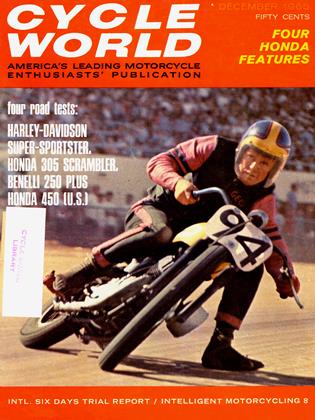HONDA 450
A revisit; we were right the first time.
IN JANUARY, 1965, CYCLE WORLD'S spies reported that there was to be a new, big-displacement Honda, and we risked the wrath of the Mysterious East by blabbing the. whole thing to our readers. Later, our Tokyo-based 007 supplied photographs and we published those as well - as you will recall. Then, fortune continued to smile and the Bird of Paradise flew in our window with an example of the new 450 Honda for us to test. It was a model made for the Japanese domestic market, but so very little different from the one destined to be sent to our shores that we elected to go ahead with the test and publish the results. In that way, we could get the information out to a lot of people who had been waiting impatiently and, in fact, we were out with a full test report, complete with performance data and technical analysis, two months before any other publication in the world.
Externally, differences between the domestic and export versions proved to be restricted to the footpegs and the aircleaner covers. The former fold, instead of being rigid; the air-cleaner covers on the export model are sprayed a nice silver where those on the domestic 450 are plain black. Turn indicators, fitted on the domestic model we tested, were missing on the export bike supplied us, but these are optional items easily added or removed.
Internally, the only differences are connected with the crankshaft, which has its crankpins set at 180-degrees in the export version. This is, as we pointed out in our test, supposed to give better balance at high revs than a 360-degree shaft. It does, however, require that two sets of ignition breaker points be used, and two coils. The domestic engine's 360 crank permits the use of a single, double-lead coil, single condenser and single set of points. All of this is slightly less expensive and well suited to Japan, where these 450s will probably be used mostly as police motorcycles and spend a lot of time slogging along at low speeds. You don't need the better balance of the 180-degree crank under those conditions.
None of these things make the slightest difference in the bike's performance. The engine has the same valve timing, the same compression ratio and the same carburetors, and it develops the same horsepower and torque at the same peaking speeds. A recheck of acceleration revealed no significant change, and as we have already stated in our previous test report, the top speed is limited by the 450's gearing. We had hoped that the export model, or at least those sent to the United States, would have slightly taller gearing, but that is not the case. Of course, a wide selection of sprockets (rear wheel and countershaft) are available so the individual owner will have no difficulty in tailoring his 450 Honda to suit his particular requirements.
One point we strongly criticized on our first test bike was its tires, which were terrible. The tires fitted on this latest, export model bear all the same markings but seem to do a much better job. We would suspect that the rubber compound has been changed. That is most fortunate. The Honda CB-450 has superb handling, and deserves good tires.
At first, during this re-test, we thought that the 180° crankshaft had made the balance worse; not better. At cruising speeds (65-70 mph) the handlebars would hit a resonance and their ends would turn into a 3-inch diameter blur — very distressing. But, we soon discovered that this was due to someone's having overtightened the bolts that run through the handlebar's rubber - bushed mountings. Loosening these bolts enough to allow the rubber some freedom of movement cured the problem.
In retrospect, we are quite pleased with our original decision to test the first 450 that came into our hands. Fears that the export version might be noticeably different proved completely groundless. Domestic and export models are the same. In fact, we could not detect any difference in high rev vibration levels. Both have an unfortunate period of vibration right in the cruising range, but both are also otherwise very good motorcycles. Easy starting, good low-speed pulling power, excellent brakes; everything. Honda has a winner.
 View Full Issue
View Full Issue







